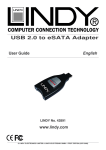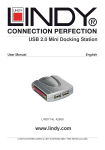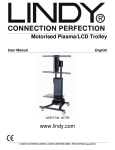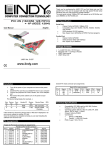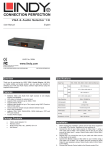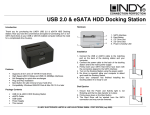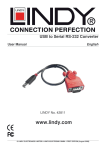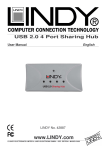Download Lindy 4-Port DVI
Transcript
4 Port DVI Audio/ Video Switch User Manual English LINDY No. 38032 www.lindy.com © LINDY ELECTRONICS LIMITED & LINDY-ELEKTRONIK GMBH Manual Introduction Thank you for purchasing the LINDY 4 Port DVI Audio/Video Switch including infra-red remote control. This switch allows routing of multiple DVI equipped devices (such as PC’s or DVD players) to a single DVI-D plasma or LCD screen. The switch supports DVI-D signal resolutions up to 1920x1200 and HDTV up to 1080p. With the included Infra-red remote control, you can switch between the four video and audio sources independently from the comfort of your chair. The internal EEPROM stores the last know configuration when the power is turned off. Package Contents • • • • 4 Port DVI Audio/Video Switch Infra-Red Remote Control Audio Extension Cable x 5 (15cm) This Manual Specifications • • • • • • • Input Ports: 4 DVI-D Ports Output Ports: DVI-D Device Selection: Push Button or Remote Control Single Link Range: WUXGA 1920 x 1200@60Hz up to 1080p PSU: 5V DC, 1A (Centre Positive) Aluminium Enclosure Dimensions: 162 x 58 x 28mm (WxDxH) Installation Note: Please make sure all devices are turned off before installation starts 1 2 3 4 5 Connect your DVI display to the DVI output with a DVI-D cable Connect the 4 DVI devices to the input port with a DVI-D cable Plug in the 5V power supply Power on all the devices Using the push button or the remote, select the source you want to view Connectors 1. 2. 3. 4. 5. 6. Video channel LED indicator: the LED will show which video channel is selected Audio channel LED indicator: the LED will show which audio channel is selected Power & AV sync button: press this button for 2 seconds to power on/off 4 x Video input ports: connect your source devices to these ports 4 x Audio input ports: connect your audio source to these ports Video output port: connect this to your display © LINDY ELECTRONICS LIMITED & LINDY-ELEKTRONIK GMBH Manual 7. 8. 9. Audio output port: connect this to your audio in port on your display IR receiver: ensure this receiver is not blocked when using the IR remote DC Power Socket: connect the supplied PSU to this port 9 1 4 2 3 7 6 8 5 Remote Control Power “on” button Power “off” button Select “video” source Select “audio” source “Mute” button © LINDY ELECTRONICS LIMITED & LINDY-ELEKTRONIK GMBH CE/FCC/Recycling Information CE Certification This equipment complies with the requirements relating to electromagnetic compatibility, EN55022/EN55024 class B for IEC/EN61000-4-2/3 the essential protection requirement of Council Directive 89/336/EEC on the approximation of the laws of the Member States relating to electromagnetic compatibility. FCC Certification This equipment has been tested and found to comply with the limits for a Class B digital device, pursuant to part 15 of the FCC Rules. These limits are designed to provide reasonable protection against harmful interference in a residential installation. This equipment generates, uses, and can radiate radio frequency energy and, if not installed and used in accordance with the instructions, may cause harmful interference to radio communications. However, there is no guarantee that interference will not occur in a particular installation. If this equipment does cause harmful interference to radio or television reception, which can be determined by turning the equipment off and on, the user is encouraged to try to correct the interference by one or more of the following measures: • Reorient or relocate the receiving antenna • Increase the separation between the equipment and receiver • Connect the equipment into an outlet on a circuit different from that to which the receiver is connected • Consult the dealer or an experienced technician for help You are cautioned that changes or modification not expressly approved by the party responsible for compliance could void your authority to operate the equipment. This device complies with part 15 of the FCC Rules. Operation is subject to the following two conditions: 1. This device may not cause harmful interference, and 2. This device must accept any interference received, including interference that may cause undesired operation. WEEE (Waste of Electrical and Electronic Equipment), Recycling of Electronic Products United Kingdom In 2006 the European Union introduced regulations (WEEE) for the collection and recycling of all waste electrical and electronic equipment. It is no longer allowable to simply throw away electrical and electronic equipment. Instead, these products must enter the recycling process. Each individual EU member state has implemented the WEEE regulations into national law in slightly different ways. Please follow your national law when you want to dispose of any electrical or electronic products. More details can be obtained from your national WEEE recycling agency. Germany Die Europäische Union hat mit der WEEE Direktive umfassende Regelungen für die Verschrottung und das Recycling von Elektro- und Elektronikprodukten geschaffen. Diese wurden von der Bundesregierung im Elektro- und Elektronikgerätegesetz – ElektroG in deutsches Recht umgesetzt. Dieses Gesetz verbietet vom 24.März 2006 an das Entsorgen von entsprechenden, auch alten, Elektro- und Elektronikgeräten über die Hausmülltonne! Diese Geräte müssen den lokalen Sammelsystemen bzw. örtlichen Sammelstellen zugeführt werden! Dort werden sie kostenlos entgegen genommen. Die Kosten für den weiteren Recyclingprozess übernimmt die Gesamtheit der Gerätehersteller. France En 2006, l'union Européenne a introduit la nouvelle réglementation (DEEE) pour le recyclage de tout équipement électrique et électronique. Chaque Etat membre de l’ Union Européenne a mis en application la nouvelle réglementation DEEE de manières légèrement différentes. Veuillez suivre le décret d’application correspondant à l’élimination des déchets électriques ou électroniques de votre pays. Italy Nel 2006 l’unione europea ha introdotto regolamentazioni (WEEE) per la raccolta e il riciclo di apparecchi elettrici ed elettronici. Non è più consentito semplicemente gettare queste apparecchiature, devono essere riciclate. Ogni stato membro dell’ EU ha tramutato le direttive WEEE in leggi statali in varie misure. Fare riferimento alle leggi del proprio Stato quando si dispone di un apparecchio elettrico o elettronico. Per ulteriori dettagli fare riferimento alla direttiva WEEE sul riciclaggio del proprio Stato 1st Edition July 2009 www.lindy.com No. 38032 © LINDY ELECTRONICS LIMITED & LINDY-ELEKTRONIK GMBH




